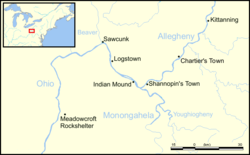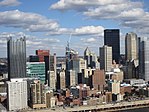Western Pennsylvania
| Western Pennsylvania | ||||||
|---|---|---|---|---|---|---|
|
||||||
 American Indian villages were located throughout Western Pennsylvania. Kittanning still uses its American Indian name, while the town of Sawcunk lies on the site of present-day Rochester, Pennsylvania. |
||||||
| Coordinates: 41°03′N 79°03′W / 41.05°N 79.05°WCoordinates: 41°03′N 79°03′W / 41.05°N 79.05°W | ||||||
| Country | United States | |||||
| Commonwealth | Pennsylvania | |||||
| Largest city | Pittsburgh | |||||
| Other cities |
List
|
|||||
| Population (2010 Estimate) | ||||||
| • Total | 4,000,000 | |||||
| Time zone | ET (UTC-5) | |||||
| • Summer (DST) | EDT (UTC-4) | |||||
Western Pennsylvania refers to the western third of the state of Pennsylvania in the United States. Pittsburgh is the region's principal city, with a metropolitan area population of about 2.4 million people, and serves as its economic and cultural center. Erie, Altoona, and Johnstown are its other metropolitan centers. As of the 2010 census, Western Pennsylvania's total population is nearly 4 million.
Although the Commonwealth does not designate Western Pennsylvania as an official region, since colonial times it has retained a distinct identity not only because of its geographical distance from Philadelphia, the beginning of Pennsylvania settlement, but especially because of its topographical separation from the east by virtue of the Appalachian Mountains, which characterize much of the western region. In the 18th century, this separateness caused some to rally for the formation of a 14th state in this region named Westsylvania. The strong cultural identity of Western Pennsylvania is reinforced by the state supreme court holding sessions in Pittsburgh, in addition to Harrisburg and Philadelphia.
Since at least the early 20th century, scholarly books such as Guidebook to Historic Western Pennsylvania, published by the University of Pittsburgh Press (1938), formally define the region as the 26 counties west of the Appalachian divide, a meridian from the north at McKean County down and along McKean's eastern border and ending in the south at Bedford County.
In alphabetical order those counties are:
...
Wikipedia




